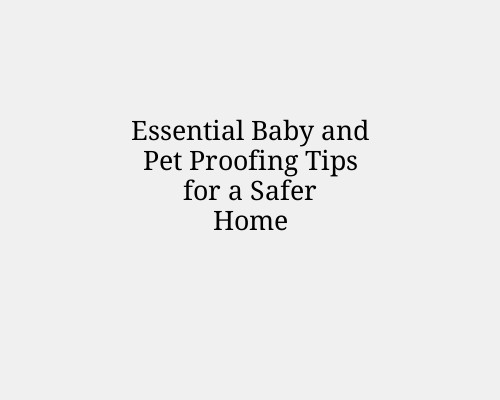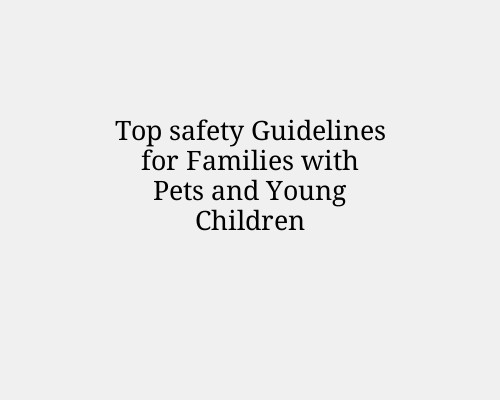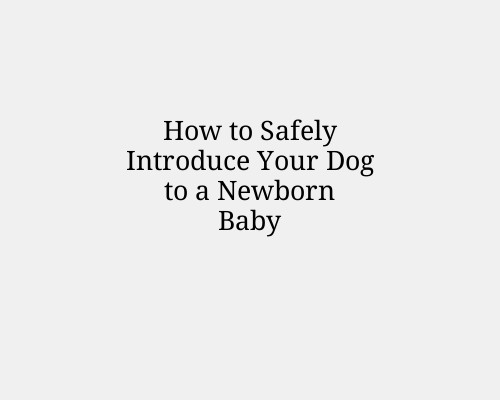
Creating a safe home environment for both babies and pets requires careful planning and awareness of potential hazards. Babies and pets are naturally curious, which makes them more vulnerable to everyday household dangers. From sharp corners and toxic substances to electrical cords and choking hazards, your home can present numerous risks if not properly safeguarded.
Here is a comprehensive guide to baby and pet proofing your home to ensure everyone stays safe and secure.
Secure Furniture and Heavy Items
Tip: Anchor bookshelves, dressers, TVs, and other heavy furniture to the wall.
Babies love to pull themselves up on furniture, and pets often jump or brush against unstable objects. Unsecured furniture can easily tip over, leading to serious injury or even death. Use anti- tip straps or brackets to keep heavy items from falling.
Install Baby and Pet Gates
Tip: Use safety gates at the top and bottom of staircases and to restrict access to unsafe rooms.
Whether it’s a curious toddler or a playful dog, staircases and certain rooms (like the kitchen or bathroom) should be off-limits without supervision. Choose gates that are pressure-mounted for easy installation or hardware-mounted for more permanent placement, especially near stairs.
Cover Electrical Outlets and Secure Cords
Tip: Use outlet covers or sliding plate covers to prevent electrocution.
Both babies and pets are attracted to cords and outlets. Use cord shorteners, covers, or concealers to prevent chewing or tripping. Tuck away or tape down exposed wires and unplug devices when not in use.
Keep Small Items and Choking Hazards Out of Reach
Tip: Store small objects like batteries, coins, buttons, jewellery, and pet toys with small parts in locked containers or high cabinets.
Choking hazards are among the leading causes of injury in children and pets. Regularly sweep the floor and low furniture for items they might pick up. Avoid giving small toys to pets that could easily be swallowed, and vice versa—keep pet chew toys away from babies.
Use Cabinet and Drawer Locks
Tip: Install childproof latches on all cabinets and drawers, especially those containing cleaning supplies, medicine, sharp objects, or pet food.
Cabinets often contain dangerous items like bleach, medications, scissors, or dog treats. Both babies and pets are prone to exploring with their mouths, so ensure all hazardous materials are locked away. Magnetic locks and adhesive-mounted latches are popular choices for ease of use.
Hide or Remove Toxic Plants
Tip: Identify all plants in your home and remove or relocate any that are toxic to babies or pets.
Common household plants like philodendron, dieffenbachia, lilies, and pothos are toxic if ingested. Even non-toxic plants can cause stomach upset or allergic reactions. Keep all plants out of reach or replace them with safe alternatives like spider plants or Boston ferns.
Secure Trash Bins and Toilet Lids
Tip: Use locking trash cans and install toilet lid locks to prevent access.
Babies and pets are notorious for rummaging through the trash and toilets. Not only is it unsanitary, but it can also be dangerous if they ingest spoiled food, sharp objects, or chemical cleaners. Opt for covered bins with latching lids and childproof toilet locks.
Avoid Hanging Cords from Blinds or Curtains
Tip: Use cordless window coverings or install cord wind-ups and cleats to prevent strangulation hazards.
Dangling cords are particularly dangerous for infants and cats. Cordless blinds are the safest choice, but if replacing them isn’t possible, tie up cords and fasten them high enough to be out of reach.
Keep Floors Clean and Clutter-Free
Tip: Regularly vacuum, sweep, and check under furniture for dropped items or pet hair build up.
Pet hair and small debris can become breathing hazards for crawling babies. A tidy floor also reduces the risk of tripping and helps you spot hazards quickly. Designate toy storage bins for both baby and pet toys to avoid cross-contamination.
Establish Pet-Free Zones for Baby and Vice Versa
Tip: Create specific areas where pets and babies can enjoy time separately when needed.
Even the gentlest pet can feel overwhelmed by a crawling baby. Use gates or room dividers to separate them when you’re not around to supervise. Train your pet to respect these boundaries and give them a safe space of their own with toys, bedding, and water.
Monitor Temperature and Humidity
Tip: Use a thermostat and humidifier to maintain a comfortable environment for both baby and pet.
Babies are sensitive to heat and cold, while pets (especially short-nosed breeds or older animals) can suffer in extreme temperatures. Keep your home between 68°F and 72°F and use a hygrometer to ensure humidity stays between 30% and 50%.
Avoid Chemical Cleaners and Opt for Natural Alternatives
Tip: Use baby- and pet-safe cleaning products such as vinegar, baking soda, and plant-based solutions.
Traditional household cleaners often contain ammonia, bleach, and other harsh chemicals that are dangerous if inhaled or ingested. Always read product labels and store cleaning supplies well out of reach. Consider switching to non-toxic alternatives that are safe for all family members.
Check for Loose or Sharp Edges
Tip: Add corner guards and edge bumpers to furniture and other hard surfaces.
Sharp corners on coffee tables, counters, or fireplace hearths pose injury risks during falls or rough play. Rubber bumpers or foam padding can absorb impact and prevent cuts or bruises.
Secure Doors and Windows
Tip: Install childproof locks and screens on windows and use door stoppers to prevent pinched fingers or paws.
Toddlers and pets can push doors open or fall through open windows. Install window guards and ensure all door locks are inaccessible to small hands or paws. You can also use lever handle locks if your baby or dog has learned to open doors.
Use Baby Monitors or Pet Cameras
Tip: Invest in a reliable video monitor system to keep tabs on your baby or pet when you’re in another room.
For peace of mind, use technology to monitor movement, sounds, or unexpected activity. Many baby monitors now double as pet cams with night vision, two-way audio, and app-based alerts.
Conclusion
Baby and pet proofing is not a one-time task but an ongoing process. As your child grows and your pet becomes more familiar with the environment, new risks may arise. Routinely inspect your home and update your safety measures as needed. By anticipating hazards and taking proactive steps, you create a secure, harmonious space for every member of your household— two-legged and four-legged alike.

